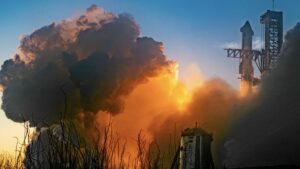A new groundbreaking measurement made by the Solar Orbiter spacecraft and the Parker Solar probe brings scientists closer than ever to solving a longstanding mystery surrounding the sun. Oddly enough, our host star’s atmosphere, or corona, is staggeringly hotter than the solar surface despite being further away from the obvious source of the sun’s heat — and this is a puzzle that has troubled physicists for about 65 years. The collaboration between these two instruments was made possible when the Solar Orbiter, operated by the European Space Agency (ESA) performed…
Read More‘Hubble Hugger’ space shuttle engine mounted on Artemis 2 moon rocket (photos)
A rocket engine that helped power a servicing mission to the Hubble Space Telescope is now readying for the moon. NASA’s Artemis 2 mission is scheduled to fly four astronauts around the moon no earlier than November 2024. The big Space Launch System (SLS) rocket that will launch Artemis 2 is coming together: Technicians at a NASA center installed the first of four recycled R-25 space shuttle engines on the powerful rocket’s core stage on Monday (Sept. 11). That engine, No. E2059, was once nicknamed a “Hubble Hugger” by NASA…
Read MoreAre we about to see a rare green comet light up the sky? An expert explains what to expect from Comet Nishimura
Of all the objects in the solar system, perhaps the most spectacular are the great comets that occasionally grace our skies. If you’ve been on social media in the past few days, you’ve probably seen articles proclaiming we have such a comet in our skies right now: C/2023 P1 (Nishimura). As I write this, Comet Nishimura is swinging past on its first visit in more than 400 years. Japanese astronomer Hideo Nishimura discovered the comet on Aug. 12. Soon after, pre-discovery images of the comet dating back to January were…
Read MoreStunning image of Andromeda galaxy takes top astronomy photography prize of 2023 (gallery)
The Royal Observatory Greenwich has announced the winners of the Astronomy Photographer of the Year 15, during an award ceremony held Sept. 14. This was the Royal Observatory Greenwich’s fifteenth year holding the contest, which garnered more than 4,000 submissions from 64 different countries for 2023. A shortlist of winning submissions was released in July, and many of those spectacular images have made a reappearance. This year’s winning image Related: Stunning James Webb Space Telescope image shows young star blasting supersonic jets As the world’s largest astrophotography competition, Royal Observatory…
Read MoreSatellites watch as Hurricane Lee swirls towards Canada (video)
Satellites are watching Hurricane Lee swirl above the Atlantic Ocean as it makes its way toward the Canadian coast for a Saturday (Sept. 16) landfall. The storm, currently a Category 1 hurricane packing winds of 80 mph (130 km/h), will likely cause power outages, storm surge flooding and flash floods along the coast of Maine, New England, Brunswick and Nova Scotia in the next 24 to 48 hours, according to NOAA and AccuWeather. Fortunately, by the time Lee hits the coast, it will have weakened into a post-tropical storm. Hurricanes…
Read MoreHigh-energy electrons in Earth’s magnetic tail may form water on the moon
High-energy electrons located in a tail of plasma around the Earth are weathering the moon and, more excitingly, seem to have given rise to water across the lunar surface. The new findings, reached by a team of researchers led by Shuai Li, a scientist at the University of Hawaii at Mānoa School of Ocean and Earth Science and Technology, could also explain how water gathers in pockets across the moon that never see sunlight called permanently shaded regions (PSRs). Knowledge of water distribution and concentration across the moon isn’t only…
Read MoreNASA Astronaut, Crewmates Reach Space Station for Science Expedition
NASA astronaut Loral O’Hara and two cosmonauts safely arrived at the International Space Station Friday, Sept. 15, bringing its number of residents to 10 for the coming week.
Read MoreNASA Releases First Season of Spanish-language Podcast
In celebration of Hispanic Heritage Month, NASA is releasing new content for Universo curioso de la NASA, the agency’s first Spanish-language podcast. A five-episode season will start Tuesday, Sept. 19, with new episodes released weekly.
Read MoreArtemis Landing and Recovery Director Liliana Villarreal
“It’s amazing when I get a chance to see the space station fly over. I am very fortunate to be able to say that my hands were on a lot of the hardware that is up there. I’m very proud to have been part of the International Space Station program.” — Liliana Villarreal, Artemis Landing and Recovery Director, Exploration Ground Systems
Read MoreNASA to Discuss Optical Communications Demo Riding with Psyche
NASA will host a media teleconference at 1 p.m. EDT on Wednesday, Sept. 20, to discuss the agency’s first test of high-bandwidth optical communications beyond the Moon. The Deep Space Optical Communications (DSOC) technology demonstration is launching aboard the Psyche spacecraft Thursday, Oct. 5.
Read More








